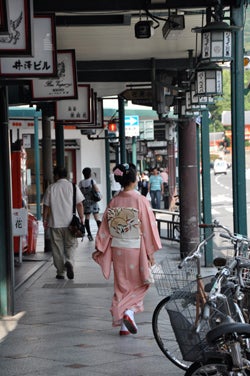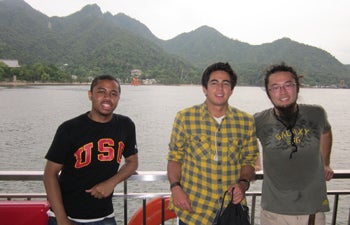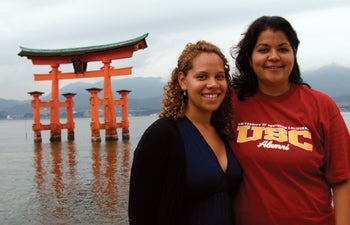Taking the Emperor’s Reign
On the Tokyo subway trains passengers were packed in like Pringles.
Each train typically had a designated “pusher” whose job was literally to shove people inside so the doors could shut. On the streets, people walked so closely behind, you could hear them breathe.
“We were jam-packed, squeezed into people,” Anthony Grimaldo said of Tokyo, his first trip abroad. “Personal space suddenly got a lot closer.”
Arriving in Japan, the USC College sophomore initially noticed space — or the lack of it. Nearly three-quarters of Japan is covered with mountains so there’s not much room to spare. With more than 30 million residents, Tokyo is the world’s largest metropolitan area. The parking structures caught Grimaldo’s eye.
“They were narrow and went straight up several stories, like an elevator,” he said. “Bike racks were stacked on top of one another. Everything was compact.”
Grimaldo researched the issue of space for USC College’s first Summer Intensive Program in Japan. He was among 13 undergraduates who spent one week exploring Japanese culture in Los Angeles, two weeks in Japan and a few days debriefing this past summer during the Norman Topping Student Aid Fund-sponsored program. So moved was Grimaldo by the experience, he has changed his major from psychology to international relations.

A geisha strolls downtown Kyoto. Photo credit Donald La.
In August, students presented their papers during Topping’s annual retreat, this year in Palm Desert, Calif. Topping supports low-income students showing a commitment to community service. Established in 1970, Topping is the nation’s only student-initiated and funded scholarship.
Most Topping scholars are first-generation college students like Grimaldo who come from the surrounding community.
“I’m a first-generation college student myself,” Topping Director Christina Yokoyama said. “When I was a student here at USC, I studied abroad. I knew the great impact it had on me and I knew the hesitation my family had about my going.”
Yokoyama wanted to give Topping scholars an opportunity to travel overseas.
“We wanted faculty onboard and there was no doubt which faculty member I wanted,” Yokoyama said of George Sanchez, professor of history, and American studies and ethnicity, in the College. “My only criterion was that we travel to a non-Spanish speaking country to take many of the students out of their comfort zone.”
Sanchez served as lead faculty adviser. Also vice dean for College diversity, he chose Japan, where he has lectured several times and already has contacts.
“We wanted to introduce students to some of the major transnational relationships that have developed between Japan and the United States since World War II,” Sanchez said, adding that an emphasis was placed on exchanges relevant to minorities and the working class in the U.S.
Throughout the trip, students discussed race and ethnicity, comparing the relatively homogenous Japan with the multiracial U.S.

William Baskerville, international relations sophomore (left); Sergio Calix, political science major; and Yushi Yamazaki, American studies and ethnicity Ph.D. candidate and Fulbright scholar, take a boat to Miyajima Island to reflect after visiting the Nagasaki Atomic Bomb Museum in Nagasaki. Photo credit Roland Wiryawan.
William Baskerville, an international relations sophomore in the College, wrote a research paper on race and ethnicity in Japan. Baskerville was one of three students who received funding for the trip from the College’s Summer Undergraduate Research Fund (SURF), which supports a project of the student’s choosing. In addition to the Topping project, Baskerville wrote a paper for SURF’s American studies and ethnicity course, taught by Sanchez.
In Japan, 98.5 percent of residents are Japanese. But while in Roppongi, a Tokyo district known for its nightlife, Baskerville noticed many Africans passing out flyers in front of clubs and stores. Talking to them, he found they were from Nigeria, Kenya, Ghana and elsewhere. They told him that many Roppongi club and store owners are Africans who tend to hire Africans. Some said they moved from Africa to Japan after being offered jobs.
Other ethnic minorities live in Japan — for example Chinese, Korean, Brazilian, Filipino — and Baskerville’s project discusses laws involving citizenship rights. He also offers his take on attitudes.
“The way race is viewed in Japan seems to be different than in the U.S.,” said Baskerville, who is half African American and half Filipino. “It seems to be treated as more of a curiosity than anything else.”
Cultural lessons were a large part of the program. Before students set off for Japan, they spent one week attending seminars and field trips in Los Angeles. The week began with lectures and a visit by Japanese Consulate General of Los Angeles Junichi Ihara.
Students toured the Toyota Motor Corporation and the Port of Long Beach, where cars are brought in from Japan. They saw the cars in post-production before they traveled to Japan, where they would visit Toyota headquarters in Nagoya and watch automobiles being made. (They said the Japan plant was highly automated and run primarily by robots.)
They studied Japanese American history by visiting Little Tokyo, the National Center for the Preservation of Democracy and the Japanese American National Museum. At the museum, a docent and World War II Japanese American internment camp survivor told personal stories about being piled with several families in a barrack without plumbing.
The museum hosted cultural etiquette lessons for the group. Students, staff and professors learned to bow, eat with chopsticks and present their business cards in the formal Japanese custom. They also learned what not to do — such as eating while walking, sticking chopsticks upright in a rice bowl or blowing their noses in public.
Maki Watanabe Isoyama, Japan Foundation senior program officer, demonstrated how to present a business card by holding the top corners and bowing slightly. The deeper the bow the more respect for the recipient. She asked Lon Yuki Kurashige, associate professor of history, and American studies and ethnicity in the College, to show the group how it’s done.
“OK, what is he doing wrong?” Isoyama asked, before pointing out that Kurashige had not been pinching two corners of the card.
Kurashige grinned, taking his mistake in stride.
“I’m learning along with everyone else,” said Kurashige, a Japanese American from Southern California, who accompanied Sanchez, Yokoyama and the students on the trip, along with two American studies and ethnicity Ph.D. candidates and an additional Topping official.

George Sanchez gives a token of appreciation to a representative from the Nagoya Civic Reception House. Sanchez, professor of history, and American studies and ethnicity in USC College, bows in the Japanese tradition to show his respect. Photo credit Roland Wiryawan.
Preparing for their trip to Tokyo Disneyland, students went to Disneyland in Anaheim and contemplated tourism and global culture. In Japan, they would visit Disney’s “America Land” and see how the U.S. was characterized. (Mainly late-16th-century colonial America was represented, students said.)
They studied globalization in baseball, followed by a trip to Dodger Stadium, where they watched Japan’s most popular ball player in the U.S., Hideki Matsui of the Los Angeles Angels of Anaheim.
Also, they took the subway to Boyle Heights, where Sanchez described the Japanese influence in the predominately Mexican American community. Besides the history lesson, the exercise prepared them for the world’s most extensive rapid transit system in Greater Tokyo. Although nothing can truly prepare one for that, Sanchez said.
“It can be maddening,” Sanchez said of the Tokyo subways. “There are 20 different lines in 20 different colors all heading different ways. You can walk 15 minutes underground to get to a platform. There’s nothing like it here in the states.”
While in Japan, students noticed that portions were served smaller than back home. They remarked on the lack of sugary sodas and noted that favorite beverages appeared to be green tea and water.
“Fountain drinks don’t exist in Japan anywhere I saw,” said Donald La, a USC Marshall School of Business student. “So there are no refills on drinks unless it’s water or tea.”
In La’s final project, he discussed healthy lifestyles in Japan, drawing on his observations that people of all ages appeared to walk and take subways everywhere. He noted that obesity seemed to be nonexistent.
What struck Jesse Ruiz were all the elderly people rushing around the chaotic metro stations. He also saw very few infants — not unexpected since Japan has a dropping birth rate coupled with one of the world’s highest life expectancies.
“I thought about my grandmothers, who are about the same ages of the older people I saw in Japan,” said Ruiz, a French major in the College who also has a major in USC Marshall. “They would never have been able to survive the metro stations of Tokyo.”
Seniors are more mobile in Japan, students said. Henry Franco, a double major in international relations and Chinese in the College, described in his final project “welfare cars” manufactured in Japan for the elderly and disabled. At the Toyota headquarters in Tokyo, officials described the welfare cars, each customized for the individual’s disability.
Discussing the possibility of exporting welfare cars to the U.S., Franco and the others thought it unlikely because Japan’s government highly subsidizes the technology.
At the Sony Computer Entertainment headquarters, students met USC College alumnus Hoon Kim, who in 1987 earned his bachelor’s in psychology. Now Sony’s senior vice president of sales and marketing communication, Kim gave students a tour of the creative gaming studio then let them play some not-yet-released games.

Undergraduate Monica Rodriguez, governing board chair for the Norman Topping Student Aid Fund (left), and Topping Director Christina Yokoyama stand near the Itsukushima Shinto Shrine on the island of Miyajima. The shrine is dedicated to the three daughters of the Shinto diety of seas and storms. Photo credit George Sanchez.
They met with officials of the chamber of commerce in Nagoya, L.A.’s sister city for the past 50 years, attended a baseball game at the Nagoya Dome, networked with members of the USC Tokyo Alumni Club and spent time with international and Japanese students at the University of Tokyo, Doshisha University in Kyoto and Nihon University in Mishima. With the critical help of alumni club President Brian Nelson, Columbia University Professor Gary Okihiro, as well as Professor Masako Notoji and other faculty at the Japanese universities, the students were warmly welcomed in Japan. What perhaps stayed with many the longest was visiting the Hiroshima Peace Memorial Museum, which tells the story of World War II’s U.S. atomic bombing of Hiroshima on Aug. 6, 1945, that killed more than 200,000.
They described the “Hiroshima shadows” cast by people caught in the explosion and incinerated; leaving dark shadows on a bank wall and steps. The museum displayed clocks stopped at 8:15 a.m. Outside, students explored the city.
Baskerville kept envisioning the city 65 years earlier.
“Mothers screaming for their children, children crying for their parents,” Baskerville said. “All of this horrific stuff. I kept trying to distance myself from, as an American, being responsible for the bombing.”
After such intensity, students relaxed, taking a boat ride to the peaceful Miyajima Island, where they reflected and discussed their emotional reactions to Hiroshima.
“History came alive for these students that day,” Sanchez said.
The team bonded, experiencing together the complexities of the Land of the Rising Sun and its transnational connection to Los Angeles and the United States. They ended the trip with a night of karaoke, kicking off with “We Are Family.”
Read the blog created by Professor George Sanchez and his students at uscamericainjapan.wordpress.com.
Read more articles from USC College Magazine’s Fall 2010/Winter 2011 issue